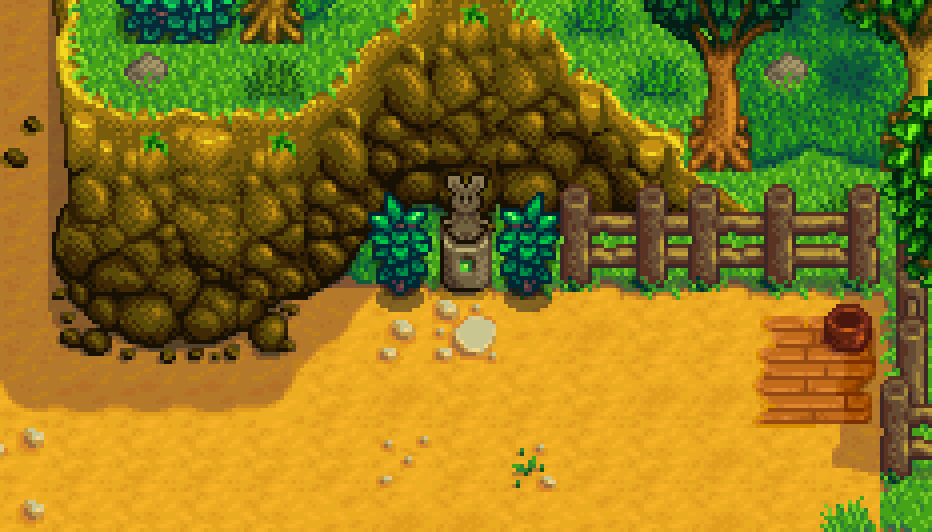Note: At the time of writing, the author has played approximately 12 hours of Stardew Valley, nearing the end of Summer of his first year. With no other Stardew Valley experience and intentionally avoidant of wiki overexposure, the author has written this post conscious of his limited perspective.
Stardew Valley does not list, amongst its various goals, the engagement of the player character with the concept of displacement of indigenous societies. The game opens with the bequeathment, from Grandfather to grandchild, of a parcel of land in the quaint and ecologically abundant Pelican Town. This area, a cabin and a plot of farmland, are understood to be in mild disrepair, but indisputably property of the player character despite the years of neglect the grounds waited through. And Pelican Town itself has been around long enough to develop a strong community, a sense of personal history, and a significant physical infrastructure integrated into its environment. Despite this, the presence of mysterious totems, dwarven relics in the mines, and magical spirits and monsters imply that the area now known as Pelican Town has a storied and intricate history — but one that only remains today as scattered and unintelligible artifacts. As interaction with these items is a constant element of gameplay, critically assessing how this interaction is framed posits Stardew Valley as a model of cultural consideration in the wider world.
The most visible of these artifacts are the many types of stone totems inlaid with gems found in various locations around the town. Each depicts an animal assumed to be native to the surrounding ecosystem, such as a rabbit or a bird. Through the first few seasons of gameplay, these totems are ever present but un-interactable to the player character. These characteristics create a network of associations a player may use to generate an idea of what these statues may be: They are abstract stone creations, referencing some older culture. They are geographically situated within the land of Pelican town. They evoke some kind of mysticism or magic with their bright gems and the way they are almost reverently framed by surrounding fauna. A particular dichotomy can be observed in the way the player approaches their inability to interact with them. Initially, it could be assumed that these totems are unintelligible because they are foreign, perpetuating the problematic concept of the uncivilized native that occurs in some uninformed discourses on indigenous artifacts. However, the opposite could instead be true: The player character is new to this culture, and indeed to Pelican Town itself, and therefore has not developed their scope of knowledge enough to engage with these pieces.
One such modem of developing cultural knowledge could, theoretically, be through the town museum. Instead, keeping in line with the long history of museums exploitatively appropriating cultural artifacts, the Pelican Town museum uncritically accepts items with very little return on their significance. The most prominent example of this pattern is the variety of Dwarvish objects the player character may find. One is encouraged to pass every item on to the museum so that Gunther, the curator, “can tell you more about [it]”. Despite this firm instruction, very rarely does Gunther’s description of any piece go deeper than a cursory explanation of its physical appearance or quality. These shallow explanations highlight the failings of the current Pelican Town residents to give proper recognition to the land’s previous inhabitants, and how failures of cultural involvement may be perpetuated by educational institutions. One of the artifact descriptions for the Dwarf Gadget describes it as follows:
![]()
“It’s a piece of the advanced technology once known to the dwarves. It’s still glowing and humming, but you’re unable to understand how it works.”
Once again, the imperative towards engagement is placed rightfully on the player character — the one who is unable to understand advanced technology, not the other way around. Of course, as more artifacts are collected and squirreled away to museum shelves, one’s curiosity of how the Dwarven society was reduced to only historical reference intensifies. One tragic possibility considers how the player character is encouraged by quests to unrelentingly dispose of seemingly endless cave monsters and creatures — the same caves which Artifacts are regularly found in.
The inability of the player character to fully understand the history of the land Pelican Town now inhabits is reflective of a greater truth in the studies of indigenous cultures: Simply put, the foreigner is and was not part of the community and therefore cannot know all that it comprised. Although this lack of information may be in part because of the developer’s limited resources and non-crucial nature of a full regional history for a resource management game, the implementation of this limited scale seems to highlight the failings of modern indigenous studies instead of perpetuate them.
Considering what has been established, the author anticipates Stardew Valley’s continuing complication and exploration of the player character’s interactions with the world they have been placed within. The presence of a non-human member of one of the established groups — Dwarven, Elven, even perhaps a sewer monster (?) — could provide historical context to deepen the portrayals of other cultures in the game; Alternatively, they could be reduced to caricature or merely a one-sided tool, which the player would only be compelled to engage with if desiring to read their dialogue like a textbook. To return to the beginning of this piece — Stardew Valley does not explicitly set out to engage with colonization and the consequences of indigenous displacement, and perhaps it is setting an unrealistic standard to expect nuanced commentary on what it means to find a helmet or right-click on a statue. However, the established thoughtful consideration of artifacts and objects, beyond just their initial mystery, implies a deliberate intent towards thoughtful representation on the behalf of the developers.
– Daisy Marshall, January 28th, 2022
All photos via the Stardew Valley Wiki
